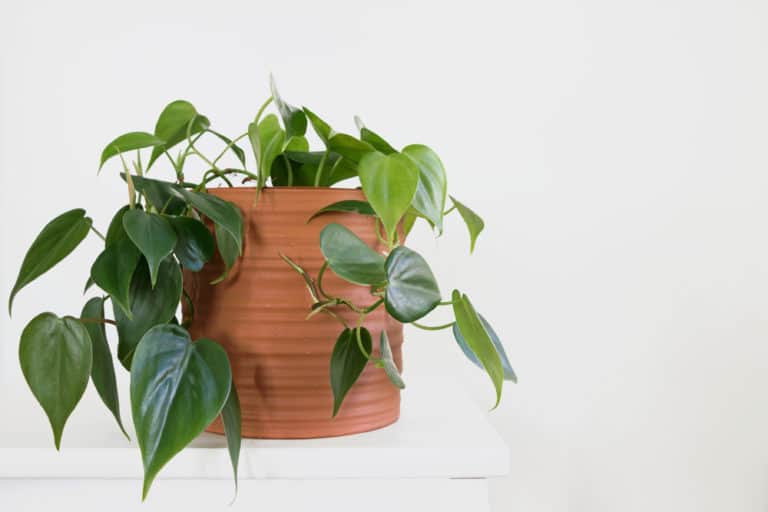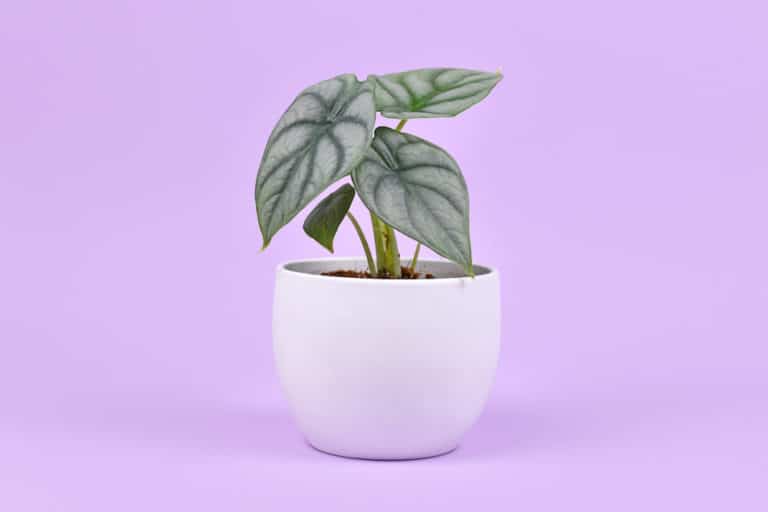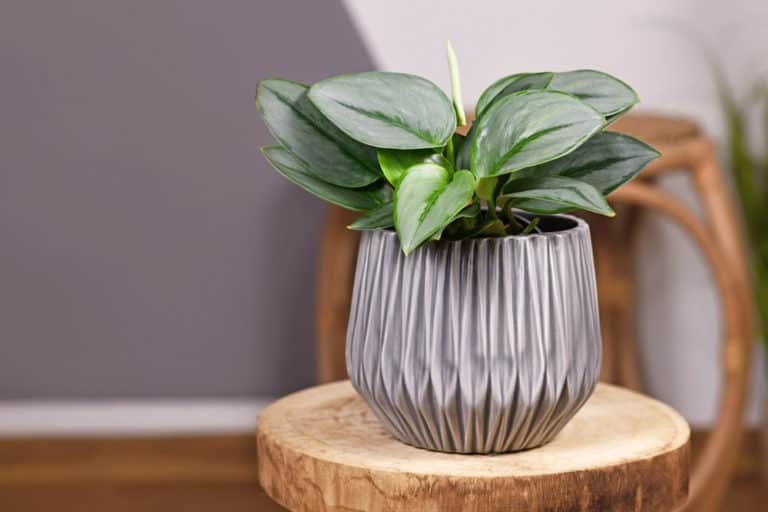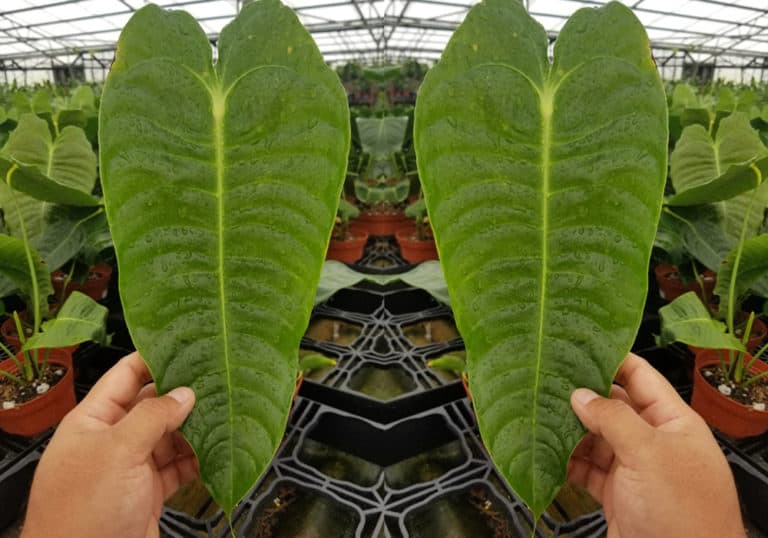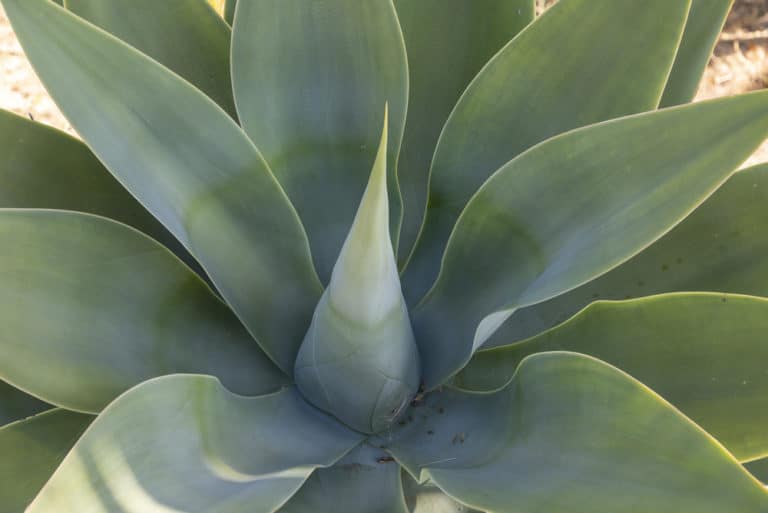Asplenium Nidus ‘Crispy Wave Fern’ Care Guide (2024)

The crispy wave fern is a new cultivar of the old favorite bird’s nest fern or Asplenium nidus.
It’s a virtually indestructible houseplant that will work beautifully as part of an indoor garden or on its own, where its sculptural looks will shine.
Even better, its large leaf surface makes it a super-star air purifier.
| Scientific Name | Asplenium nidus ‘Crispy Wave’ |
| Common Name | Crispy Wave Fern, Japanese Asplenium Nidus, Pleated Bird’s Nest Fern |
| Light | Bright indirect sunlight |
| Watering | Water when the top inch of soil is dry |
| Temperature | 70 to 90ºF (21 to 32ºC) |
| Hardiness Zone | 9 to 12 |
| Humidity | 60 to 90% |
| Soil Type | Rich, quick-draining, loamy |
| Soil pH | 5 (acidic) |
| Fertilizing | Once a month in spring and summer |
| Repotting | As needed |
| Pruning | Only to remove damaged leaves |
| Propagation | By spores |
| Toxicity | Not toxic to humans and pets |
| Mature Size | 18 to 24 inches as a houseplant |
| Bloom Time | No flowers |
What’s Unique About Crispy Wave Fern?
The crispy wave fern plant was patented in 2010 as a new cultivar of the bird’s nest fern. It was bred in Japan.
The parents of the crispy wave fern plants are native to the Malay Archipelago and Queensland, Australia. There, they usually grow on branches or palm leaves high in the tree canopy.
It has long, narrow, deeply pleated leaves with a bright green hue that will add a pop of color and a distinct, architectural look to any indoor space.
Growing crispy wave fern is easy once you’ve mastered its watering and humidity needs, and in fact it’s almost impossible to kill.
Crispy Wave Fern Care
In the rainforests of the Malay Archipelago where the Asplenium nidus originates, these tough ferns live in the shade of the tree canopy.
Crispy wave fern plant care should take into account the hot, humid conditions that these tropical ferns have evolved in.
Your Asplenium nidus care needs to include a warm, humid environment with bright, indirect light to keep it happy.
Light
In its native rainforests, the Asplenium nidus is used to getting an average of between 4 to 6 hours of sunlight a day. That’s because it’s often raining.
That sunlight isn’t the direct tropical sun, either; it’s filtered through the tree canopy before it reaches the understory plants.
In your home, crispy wave fern light requirements are for bright but indirect light, or between 10,000 and 20,000 lux.
It’s easy to meet these Asplenium nidus light needs no matter what direction your windows face.
If you’ve got a north or east exposure, you can set the plants directly in the window.
However, if your only options are south or west, you need to keep them out of the full sun, which will burn its fronds.
Watering
It’s pretty consistently wet in the Malay Archipelago, with rain falling every 2 or 3 days, with total accumulations of at least an inch a week, even in the dry season.
It’s a good idea to try to replicate that in your home. It’s advised that you water Asplenium nidus every day, or at least several times a week. Always water the soil, and not in the rosette.
This does not mean that your crispy wave fern watering will result in soaking wet soil. Rather, because it should be in a porous mix, the medium will only stay consistently moist, letting the roots breathe.
In winter your crispy wave fern’s watering needs will ease off, so water less frequently.
Temperature
The average maximum temperature for Asplenium nidus in its native home is over 86ºF (30ºC), and the average low never gets below 70ºF (21ºC).
The crispy wave fern temperature range for your home is similar: 70 to 90ºF (21 to 32ºC).
Realistically, while you can easily accommodate the low end of that scale indoors, your crispy wave fern is only going to get to enjoy the maximum outdoors in summer.
Just be sure to bring it in before temperatures fall below 55ºF (13ºC), as it has little temperature tolerance under that. However, it can survive a brief exposure as low as 36ºF (2ºC).
Of course, this tropical native has no frost hardiness and must not be exposed to freezing temperatures.
Humidity
The relative humidity in the rainforests of the Malay Archipelago never falls below 80%.
There’s no way around it: crispy wave fern humidity requirements are high. The ideal humidity for Asplenium nidus is between 60 to 90%.
The most efficient way to raise the humidity level for your crispy wave fern is grouping all your plants together and using a small humidifier. That will keep the air moist for your tropical plants without turning your whole home into a sauna.
Crispy wave fern is one plant that can absolutely be helped with regular misting, as much as 2 times a day in winter.
Soil
In the rainforest, Asplenium nidus usually grows not in the ground, but on the branches of trees.
As a consequence, your crispy wave fern soil should be high in organic matter, and very loose and porous.
The required pH level for Asplenium nidus is 5, or acidic.
You can easily make a custom soil mix for your crispy wave fern.
A combination of peat moss, perlite, compost or worm castings, and pine bark will provide all the essentials that your crispy wave fern needs to grow happily.
You can also use a commercial cactus or succulent soil for Asplenium nidus.
Fertilizer
While it’s important to use some crispy wave fern fertilizer, you need to be careful not to burn its roots and foliage by using too much.
You should use a liquid fertilizer for Asplenium nidus with a fertilizer ratio of 24-8-16. Since it is only a foliage plant, it can use the extra nitrogen.
Dilute the mixture to half the recommended strength and pour it slowly and evenly over the soil surface, and not in the central rosette.
Use fertilizer once a month in spring and summer, right after you’ve watered.
If the fronds get brown spots, you may be over-feeding. Flush the soil with a gentle stream of water for several minutes, and take a break from fertilizing for a while.
Potting & Repotting
Crispy wave fern repotting only needs to be done when the roots have filled up its current pot.
There’s a lot of variation in how long that will take, as it’s a slow-growing plant and much depends on the quality of its growing conditions.
However, when the foliage has become so top-heavy your pot falls over, it’s time for repotting Asplenium nidus.
Move it up one pot size so as not to have too great a proportion of soil to roots.
It’s best to use a heavy clay pot to provide a counterweight to the plant. It should be glazed to conserve the soil moisture your crispy wave fern craves. And it has to have drainage holes.
Fresh potting soil will prevent a build-up of pathogens that could hurt your crispy wave fern.
Pruning
There is little crispy wave fern pruning necessary. It naturally grows into such a lovely form that you will not want to tamper with it.
As well, it grows slowly, so there’s no rampant new growth to keep under control on a regular basis.
However, you do need to remove dead or diseased fronds. Leaving them on the plant will spoil its appearance, and will foster disease and attract insect pests.
When cutting Asplenium nidus, use sterilized scissors or clippers. Trim the leaf right back as close to the base as possible. This will encourage fresh new leaves to grow.
Propagation
Crispy wave fern propagation can be quite challenging. The only way to propagate Asplenium nidus is through spores.
As well, the patent on crispy wave fern runs until 2028, so you are not allowed to sell any plants that you may propagate.
When spores appear on the underside of your fern’s fronds, let them mature and then remove a frond and leave it on a piece of paper until the dried spores fall off.
Sprinkle them on a moist growing medium such as peat moss, and keep them damp and warm until they start to sprout.
When they’re big enough, plant them out in small pots and be prepared to baby them for a long time.
The whole process may take eight months.
Common Problems of Crispy Wave Fern
There are not a lot of crispy wave fern problems to worry about.
However, you may still experience some problems with Asplenium nidus, but you should be able to deal with most of them and save your plant.
Let the leaves tell you if there’s something wrong. Inspect them regularly for signs of disease and pest infestation.
Pests
Most crispy wave fern pests can be prevented by spraying with insecticidal soap or a neem oil solution.
Your Asplenium nidus will be less attractive to bugs if you keep it in the most ideal growing conditions. Insects are more likely to target stressed plants.
Scale will not look like bugs, but rather small brown bumps on the leaves. They will also leave a sooty mold from their honeydew as they feed on the sap.
Mealybugs form masses of white cotton on the leaves.
You can wipe these two pests off with a cotton ball soaked in rubbing alcohol.
Aphids are small greenish bugs that gather under the leaves. Take your crispy wave fern to the sink and give it a good spraying to get rid of them.
Diseases
The most likely crispy wave fern diseases are caused by water, either through too much watering or incorrect watering.
A common disease with Asplenium nidus is leaf rot, which is caused when water accumulates in the central rosette. You must cut out the rotting leaves and in future, never let water sit in there.
Root rot is the other disease to look out for with your crispy wave fern. It will manifest itself in yellowing, drooping leaves and black, smelly roots.
If you catch it early enough, you may be able to save the plant by cutting out all the affected leaves and roots, and replanting it in a fresh soil and clean pot.
Growing Problems
You may also have some growing problems which are caused simply by growing conditions that aren’t what your crispy wave fern needs to flourish.
Your sick plant should recover once you’ve fixed those issues.
Brown tips on its leaves could mean low humidity, not enough soil moisture, or too much sun.
A drooping crispy wave fern may indicate that it’s not getting enough light, and the leaves are stretching down and out to get as much as possible.
Find a brighter spot for it, and give the pot a quarter turn once a week to make sure it’s growing evenly.
Toxicity of Crispy Wave Fern
Asplenium nidus is not at all toxic to humans or animals.
Its lack of toxicity makes it a perfect plant to use around children and pets, unlike some many tropical plants.
However, for both the sake of your children and animals, it’s best to discourage their interaction with your crispy wave fern.
For Humans
Because crispy wave fern is not toxic to humans, you don’t have to take any precautions when handling this houseplant.
However, you should still strongly discourage children from getting too up-close and personal with your crispy wave fern.
One issue is that you don’t want your plant wrecked by a rambunctious kid.
As well, the fertilizers and insecticides you use on your crispy wave fern, even if they’re organic, are not something you want children ingesting.
And finally, while the Asplenium nidus is not toxic, many other houseplants are poisonous, and your toddler won’t be able to tell the difference.
For Pets
Asplenium nidus is not toxic to pets, which is a great thing when you have cats or dogs who love to nibble on plants.
At the same time, you really don’t want your pets treating your crispy wave fern like a salad bar.
Canines and felines are both carnivores, and their digestive systems have evolved to process meat.
While small amounts of plant material are okay, too much can cause gastrointestinal distress.
In other words, they may have an episode of vomiting and diarrhea after eating crispy wave fern foliage.
It’s best to find a place for your plants out of their reach.
Crispy Wave Fern Appearance
The crispy wave fern appearance is a snazzy new version of the bird’s nest fern, which has been a classic house and landscape plant for a long time.
While it never flowers, as it is a true fern, its brightly colored and extravagantly pleated leaves more than make up for that.
Foliage
The foliage of crispy wave fern is an absolute delight, with its bright color and unique form. Not surprisingly, given its name, the leaves are crisp, with pleats creating a wavy look.
Each new leaf emerges from the center rosette, first as a curled up spiral, and then unfurling to reveal its deeply pleated form.
Leaves are 2 to 8 inches long, with the longest leaves in the center. They are long and narrow, with a sword shape.
Crispy wave fern leaves are a bright apple green.
The leaves have a very stiff and crisp texture, with a smooth, glossy surface.
Flowering
You will never see a Asplenium nidus flower, because they are ferns, and ferns have spores rather than flowers.
Instead of your crispy wave fern flowering, it will produce sori made up of individual spores after several years of growth.
So rather than your crispy wave fern blooming, it will develop hundreds of narrow lines running on the diagonal out from the center vein.
They will eventually ripen and fall off, but in the meantime they add an interesting texture to those already gorgeous pleated leaves.
If you have an allergy to the spores, it might be a good idea to move your crispy wave fern out to a balcony or deck until they have finished.
Size and Growth
The size of crispy wave fern depends on how big a pot you put it in.
Indoors, they will usually stop at about 18 to 24 inches tall, with a spread of 12 to 18 inches.
However, they can continue to grow to 5 feet tall if given a large enough pot, and consistently high humidity.
Crispy wave fern has a slow growth rate, averaging less than a half inch a month during its growing season. It can take 20 years to reach its full size.
It has an overall rosette shape, with a small central rosette that is hairy and brown.
Crispy Wave Fern Fragrance
Do not expect to smell any crispy wave fern fragrance. The foliage has no scent, and it produces spores, not flowers.
However, this fern is considered an excellent air purifier, which is arguably more valuable than a fragrance.
Its deeply pleated leaves provide more surface area for producing oxygen to enrich the air, while removing large quantities of carbon dioxide.
As well, because the leaves are so thick, they are better at filtering out chemicals such as formaldehyde.
Finally, scentless plants are preferred in most public settings, because many people have sensitivities to fragrance.
These reasons make crispy wave fern a great choice on all counts.
Suggested Uses for Crispy Wave Fern
You have so many options for how to use your crispy wave fern, indoors or outdoors.
Because it’s completely non-toxic, you’re not really limited by any safety concerns.
Since it thrives in high humidity, it’s a natural choice for a bathroom with some natural light.
You may also want to place one in your bedroom for its excellent air purifying qualities.
Its bright green color and dramatically pleated leaves make it perfect as an accent plant all on its own, while it will also be an excellent foil for flowering plants.
On a balcony or patio, a row of crispy wave fern plants in tall planters would create an effective visual barrier.
FAQ
What is crispy wave fern?
The crispy wave fern is a recent cultivar of the bird’s nest fern, which is native to the tropical rainforests of the Malay Archipelago and Australia.
How to identify crispy wave fern?
The crispy wave fern has long, narrow leaves which are bright green, deeply pleated and very stiff and upright, growing out of a brown central rosette.
How to care for crispy wave fern?
The crispy wave fern should be grown in very loose, porous soil which is kept consistently moist, and kept in a warm, humid environment in bright but indirect light.
How to grow crispy wave fern indoors?
The crispy wave fern can be grown indoors as long as it is kept in a moderately warm location out of the full sun, with high humidity.
How to grow crispy wave fern outdoors?
The crispy wave fern can be grown outdoors in a tropical or subtropical zone, either in the ground or as a container plant, in a shady location and with frequent watering.
How fast does crispy wave fern grow?
The crispy wave fern grows very slowly, averaging less than half an inch a month during its growing season. It can take 20 years to reach its full size.
How tall does crispy wave fern grow?
The crispy wave fern usually reaches a maximum size of 2 feet indoors, although it will grow to match the size of its pot when given high enough humidity.
How to make crispy wave fern grow faster?
The crispy wave fern depends on high humidity for optimal growth, so to achieve the fastest growth, it needs 90% humidity in a warm or hot environment.
How to stake crispy wave fern?
The crispy wave fern does not need to be staked to maintain its upright growth habit, but rotate the pot a quarter turn weekly to prevent it from leaning in one direction.
How to pot crispy wave fern?
The crispy wave fern should be planted in very loose soil with plenty of organic matter, in a glazed clay pot with good drainage holes. Only repot when it is rootbound.
How to revive crispy wave fern?
If your crispy wave fern soil has dried out, you may be able to revive it by soaking the whole pot in a pail of tepid water until the soil is fully hydrated.
Why is my crispy wave fern dying?
Your crispy wave fern may have crown rot from water collecting in the center rosette. Never water the center of the plant, always the soil.
Why is my crispy wave fern drooping?
The crispy wave fern may seem to be drooping when the leaves are actually stretching out to reach the brightest available light. Move it to a brighter location.
How cold can crispy wave fern tolerate?
The crispy wave fern has little tolerance for temperatures below 55ºF (13ºC) for any length of time, but can survive a short exposure as low as 36ºF (2ºC)
How to get rid of pests on crispy wave fern?
You can deter most pests from your crispy wave fern with sprays of insecticidal soap or neem oil, or by wiping down the leaves regularly.
Is crispy wave fern toxic to cats?
The crispy wave fern is not toxic to cats. However, they do not digest plant material well and may have vomiting and diarrhea if they eat too much foliage.
Is crispy wave fern toxic to dogs?
The crispy wave fern is not toxic to dogs, but because they are naturally carnivores, their digestive systems do not react well to ingesting vegetation.
Is crispy wave fern toxic to children?
The crispy wave fern is not toxic to children, but they may be exposed to chemicals that you have used on your plant such as insecticides or fertilizers.
Is crispy wave fern toxic to humans?
The crispy wave fern is not toxic to humans, so you do not have to take any precautions such as gloves while pruning or repotting the plant.
Does crispy wave fern have a scent?
The crispy wave fern has no scent, but it will produce large amounts of oxygen and filter contaminants such as formaldehyde from your indoor air.


